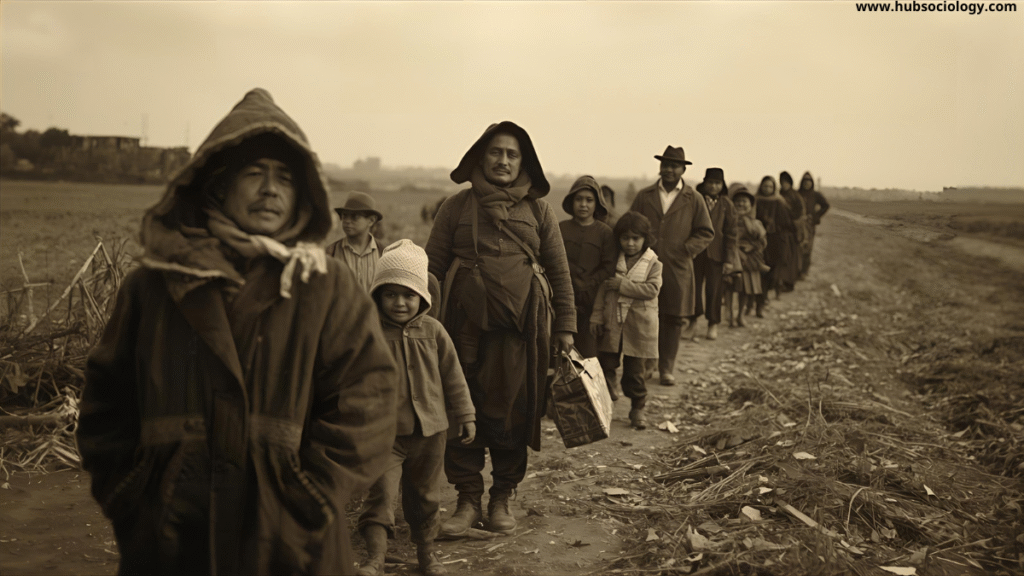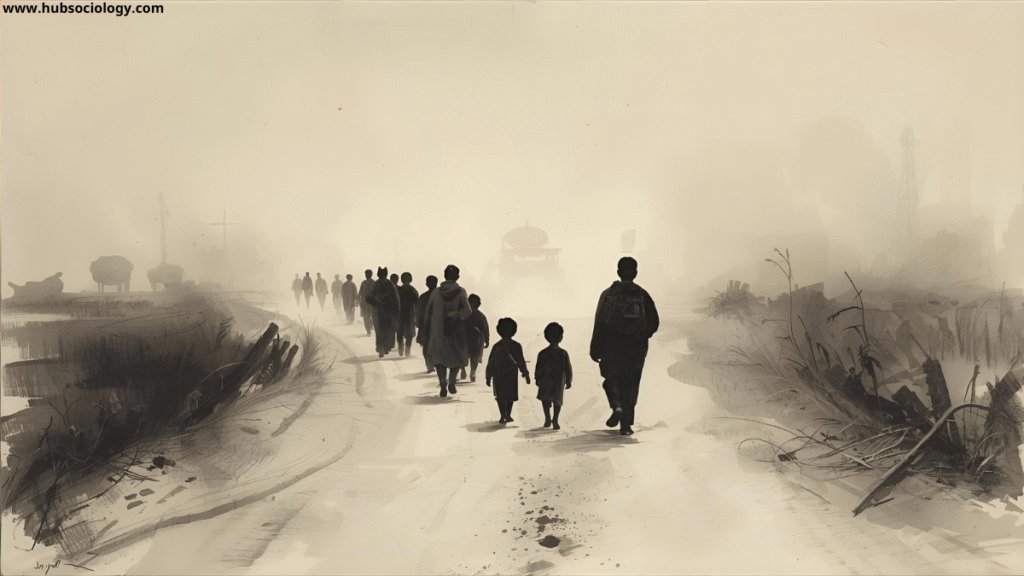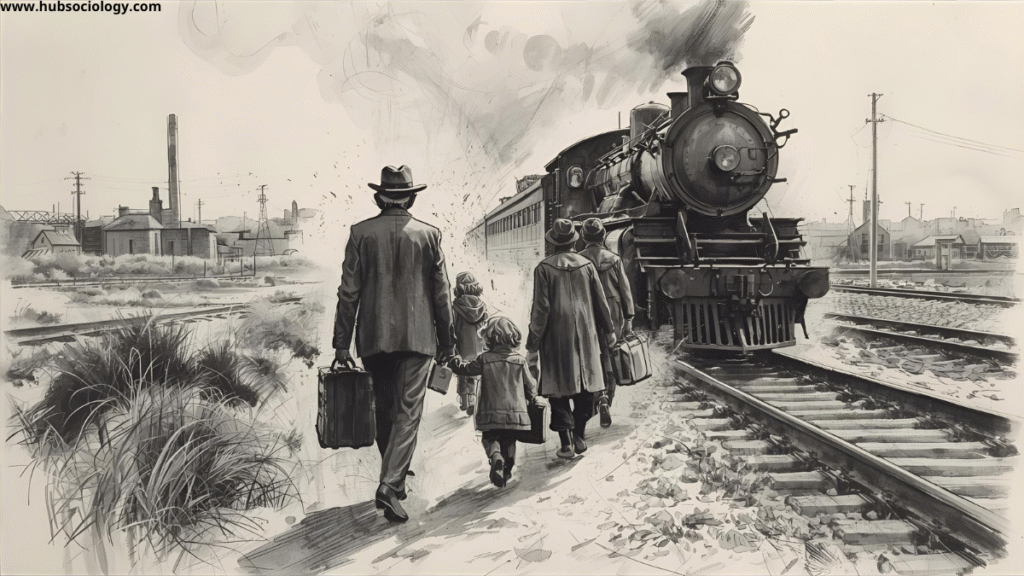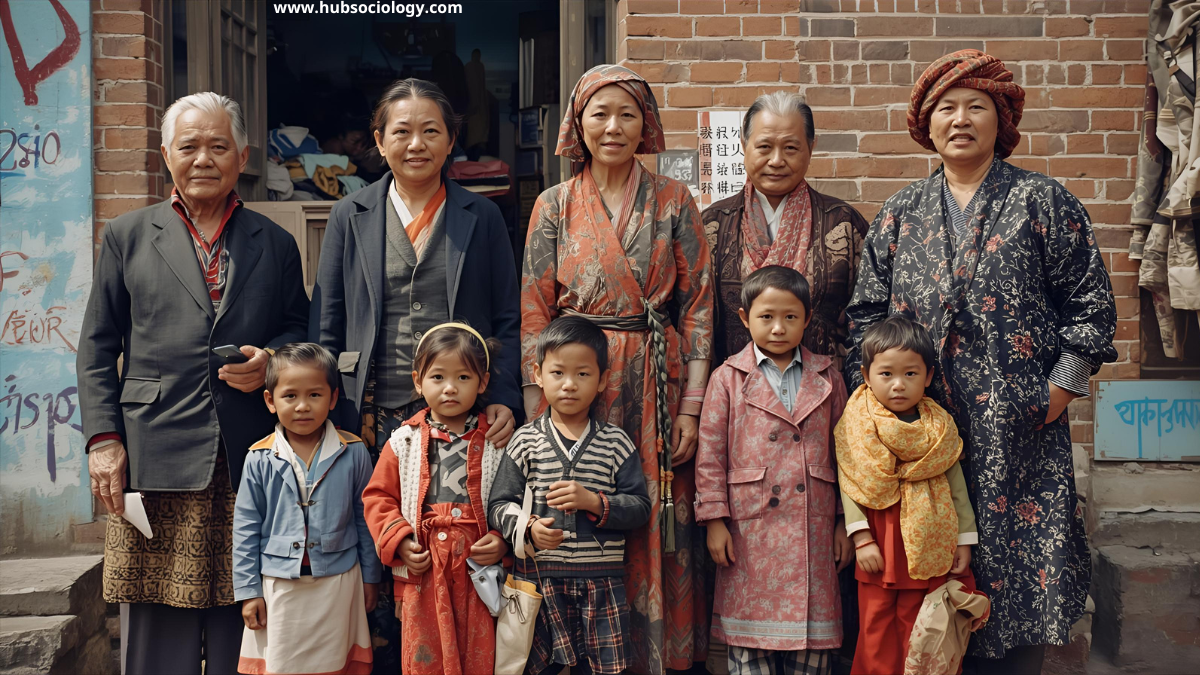Introduction on Post-Independence Migration to West Asia
Migration is one of the most significant social processes that has shaped human societies across history. In the context of India, the post-independence era witnessed distinctive migration patterns that influenced both the country and the regions where Indians settled. Among these, migration to West Asia (commonly referred to as the Gulf or Middle East region) stands out as a remarkable sociological phenomenon. From the 1950s onwards, millions of Indians, particularly from states such as Kerala, Tamil Nadu, Andhra Pradesh, Uttar Pradesh, and Bihar, migrated to West Asia, primarily seeking employment and better life opportunities. This movement was deeply rooted in global political economy, oil-led economic growth in the Gulf, and India’s socio-economic conditions.
Understanding this migration in a sociological framework involves examining not only the push and pull factors but also the cultural, familial, and identity transformations that accompanied the process. Post-independence migration to West Asia offers valuable insights into transnationalism, labor relations, remittances, and the social consequences of large-scale mobility.

Table of Contents
Historical Context of Post-Independence Migration to West Asia
The roots of Indo-Arab connections go back centuries, through trade and cultural exchange. However, the large-scale, organized labor migration of Indians to West Asia began only after Indian independence in 1947. Several historical events influenced this trend:
- Oil Discovery and Economic Boom in the Gulf – The 1970s oil crisis and the subsequent oil boom created an unprecedented demand for cheap, skilled, and semi-skilled labor in countries like Saudi Arabia, Kuwait, Bahrain, Qatar, Oman, and the United Arab Emirates.
- India’s Demographic Pressure – Post-independence, India faced challenges of population growth, unemployment, and uneven regional development. Migration to West Asia emerged as a coping mechanism for economic survival.
- Government Policies and Migration Channels – Recruitment agencies, both formal and informal, facilitated the movement of workers. Over time, both the Indian government and Gulf states institutionalized migration policies that structured the flow.
Sociological Dimensions of Post-Independence Migration to West Asia
1. Push and Pull Factors in Migration Sociology
Migration theories in sociology—such as push-pull theory and world systems theory—help explain the flows to West Asia.
- Push Factors: Poverty, underemployment, agrarian crisis, and lack of industrialization in post-independence India pushed people to look beyond national borders.
- Pull Factors: The Gulf economies offered high wages, tax-free income, and opportunities for unskilled, semi-skilled, and professional workers.
This combination of global capitalist demand and local structural poverty set the stage for massive migration.

2. Regional Patterns of Migration
The migration was not uniform across India. Certain regions became dominant suppliers of labor:
- Kerala: Known as the heartland of Gulf migration, with social networks, education levels, and historical ties encouraging large-scale movement.
- Tamil Nadu & Andhra Pradesh: Supply of semi-skilled labor in construction and domestic work.
- Uttar Pradesh & Bihar: Outmigration of unskilled male workers due to agrarian stagnation and unemployment.
This regional selectivity also reshaped local economies and cultures, with Gulf remittances transforming villages and towns.
3. Impact on Family and Gender Relations
Migration to West Asia had profound implications for family structures:
- Male-Dominated Migration: Initially, migration was largely male-centric. Men left for work, while women managed households in India.
- Feminization of Migration: Over time, women also migrated, particularly for domestic work and nursing, challenging traditional gender norms.
- Changing Family Roles: Absence of men created ‘female-headed households,’ altering authority and decision-making within families.
- Children and Transnational Families: Many children grew up with absent parents, leading to emotional strains but also upward mobility due to better financial resources.
4. Remittances and Social Mobility
One of the most visible outcomes of Gulf migration has been remittances. From building concrete houses to financing education and healthcare, remittances significantly altered local societies.
- Economic Impact: Entire regions like Kerala’s Malabar coast saw an economic boom due to Gulf money.
- Social Stratification: Migration created a new middle class, while also widening inequalities between migrant and non-migrant households.
- Conspicuous Consumption: Sociologists have noted how remittances encouraged consumerism, visible in architecture, weddings, and lifestyle changes.
5. Identity, Culture and Transnationalism
Migration fostered a new sense of identity among Indians in West Asia.
- Diasporic Identity: Migrants lived as temporary laborers, often without citizenship rights, creating a precarious existence.
- Cultural Exchange: Food, language, and religious practices traveled across borders, shaping a hybrid cultural space.
- Transnational Networks: Families maintained close ties through letters, phone calls, and later digital platforms, sustaining dual belonging to both India and the Gulf.
6. Exploitation and Vulnerability of Migrant Workers
Sociological perspectives also emphasize the darker side of migration:
- Kafala System: Migrants were bound to employers, often with limited freedom and protection.
- Labor Exploitation: Poor working conditions, low wages, and lack of social security were common.
- Legal Marginality: Migrants lacked political rights in host countries, making them vulnerable to abuse and deportation.
- Social Isolation: Migrants often lived in camps, away from families, facing cultural alienation.
7. Return Migration and Social Reintegration
Migration to West Asia was often temporary, with many workers returning after contracts ended. Return migration had mixed outcomes:
- Positive Reintegration: Some invested remittances in businesses, agriculture, or children’s education.
- Challenges: Others struggled to readjust, faced unemployment, and experienced downward mobility.
- Cultural Shifts: Returnees often carried new ideas about lifestyle, religion, and modernity, influencing social change in their home regions.
Broader Sociological Implications of Post-Independence Migration to West Asia

1. Class and Social Stratification
Migration created a new class hierarchy—those with Gulf connections enjoyed prestige and financial stability, while others remained marginalized.
2. Religion and Migration
Muslims from Kerala, Andhra Pradesh, and Uttar Pradesh formed a significant part of migration flows, partly due to cultural familiarity with West Asia. This reinforced religious networks while also reshaping community life in India.
3. Globalization and Dependency
Migration highlighted India’s integration into global labor markets. Gulf states depended on Indian labor, while Indian households became dependent on Gulf remittances—a form of economic interdependency that continues today.
4. Policy and Governance
The Indian government established institutions like the Ministry of Overseas Indian Affairs (later merged with MEA) to manage migrant welfare, reflecting the growing significance of migration in national policy.
Conclusion on Post-Independence Migration to West Asia
Post-independence migration flows to West Asia are not merely an economic story but a deeply sociological phenomenon. They illustrate how global economic shifts, local poverty, and social aspirations intersect to create massive human mobility. From remittances that transformed rural economies to the vulnerabilities of migrants under the kafala system, this migration encapsulates both opportunities and hardships.
Sociologically, it reshaped family structures, gender roles, class hierarchies, and cultural identities, making it one of the most transformative processes in modern Indian society. Even today, as Gulf economies diversify and India’s workforce evolves, the legacy of post-independence migration continues to shape the social fabric of both regions.
Do you like this this Article ? You Can follow as on :-
Facebook – https://www.facebook.com/hubsociology
Whatsapp Channel – https://whatsapp.com/channel/0029Vb6D8vGKWEKpJpu5QP0O
Gmail – hubsociology@gmail.com
Topic Related Questions on Post-Independence Migration to West Asia
5 Marks Questions on Post-Independence Migration to West Asia
- Define migration and explain its relevance in the context of West Asia.
- Mention two major push and pull factors responsible for Indian migration to West Asia after independence.
- Highlight the role of remittances in transforming rural households in India.
- What is the Kafala system and why is it significant in understanding Gulf migration?
- Write two sociological consequences of return migration from West Asia.
10 Marks Questions on Post-Independence Migration to West Asia
- Discuss the regional patterns of post-independence migration from India to West Asia.
- Examine the impact of migration to West Asia on family structures and gender relations in India.
- Analyze how Gulf remittances have contributed to social mobility and class formation in Indian society.
- How do transnational identities and diasporic communities emerge in the context of Indian migration to West Asia?
- Assess the challenges faced by Indian migrant workers in West Asia, with reference to labor exploitation and social isolation.
15 Marks Questions on Post-Independence Migration to West Asia
- Critically analyze the post-independence migration flows from India to West Asia using the push-pull theory and world systems theory.
- Discuss the broader sociological implications of migration to West Asia in terms of class, religion, globalization, and policy-making.
- Evaluate the dual impact of migration to West Asia—economic development through remittances and social vulnerabilities of migrants.
- How has return migration from West Asia reshaped social, cultural, and economic life in sending regions like Kerala and Uttar Pradesh?
- Migration to West Asia has been both an opportunity and a challenge. Discuss this statement with sociological evidence.
